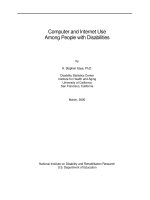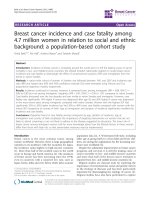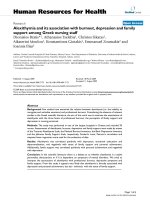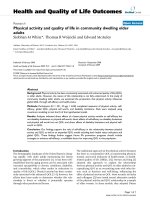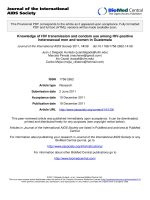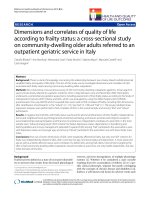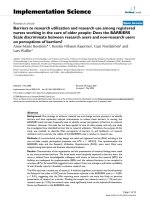Depression and healthcare use among community dwelling older adults in singapore
Bạn đang xem bản rút gọn của tài liệu. Xem và tải ngay bản đầy đủ của tài liệu tại đây (3.64 MB, 149 trang )
DEPRESSION AND HEALTHCARE USE AMONG
COMMUNITY-DWELLING OLDER ADULTS IN SINGAPORE
FENG LIANG
NATIONAL UNIVERSITY OF SINGAPORE
2008
DEPRESSION AND HEALTHCARE USE AMONG
COMMUNITY-DWELLING OLDER ADULTS IN
SINGAPORE
FENG LIANG
(MASTER OF MEDICAL SCIENCE)
A THESIS SUBMITTED
FOR THE DEGREE OF DOCTOR OF PHILOSOPHY
DEPARTMENT OF PSYCHOLOGICAL MEDICINE
NATIONAL UNIVERSITY OF SINGAPORE
September, 2008
I
ACKNOLEDGEMENTS
I wish to express my gratitude to everyone who made the realization of this thesis
possible.
My deepest gratitude, of course, goes to my supervisor, Associate Professor Ng Tze Pin. I
am grateful for his enthusiasm and encouragement; for generously sharing his skills and
good judgement; for the close support and guidance over the 4 years; for his being
considerate and giving me time to complete my thesis in the later stages of my study.
I also want to express my sincere appreciation to Professor Kua Ee Heok and Associate
Professor Tan Chay Hoon for sharing their clinical knowledge; for their creative
discussion, valuable comments and stimulating collaboration and co-authorship.
Furthermore, I have to thank Dr Reshma A Merchant for his valuable suggestions and
expertise in finishing my study.
A very kind gratitude is extended to all my colleagues in the Department of Psychological
Medicine and the nurses of the Singapore Longitudinal Aging Study (SLAS). Thank you
for your support, encouragement and kind friendship, especially when I had severe lower
back pain and leg pain. I am very lucky to work with you!
It is a pleasure to pay tribute also to all the study participants. I am grateful that they were
so patient and cooperative in all the studies.
Finally, I would like to give special thanks to my wife Yuguang, whose patient love
enabled me to complete this thesis.
II
CONTENTS
ACKNOWLEDGEMENT
I
ABSTRACT
V
LIST OF TABLES
VII
LIST OF ABBRIVIATIONS
VIII
LIST OF APPENDICES
X
CHAPTER 1 INTRODUCTION
1.1.The impact of escalation of aging population on healthcare use
1
1.2 Epidemiology of late-life depression and its association with healthcare use
2
1.3 Research Objectives
5
CHAPTER 2 LITERATURE REVIEW
2.1 Depressive symptoms or depression and healthcare use
7
2.1.1 General population
7
2.1.1.1 Community sample
2.1.1.2 Clinical sample
2.1.2 Older adults
10
2.1.2.1 Community sample
2.1.2.2 Clinical sample
2.1.3 Summary: depression and healthcare use
14
2.2 Prevalence and predictors of CAM use
15
2.2.1 Prevalence of CAM use
16
2.2.2 Predictors of CAM use
17
III
2.2.3 Summary: predictors of CAM use
23
2.3 Drug use and depressive symptoms
25
2.3.1 Antihypertensives
25
2.3.2 Lipid-lowering drugs
28
2.3.3 Corticosteroids
29
2.3.4 H2-blockers
31
2.3.5 Other drugs
32
2.3.6 Summary of Drug use and depressive symptoms
33
CHAPTER 3 METHODOLOGY
3.1 Study population
35
3.1.1 Study I and Study III
3.1.2 Study II and Study IV
3.2 Study variables
37
3.2.1 Dependent variables
3.2.2 Independent variables
3.3 Data analysis
3.3.1 Study I
45
3.3.2 Study II
3.3.3 Study III
3.3.4 Study IV
CHAPTER4 RESULTS
4.1 Study I
49
4.2 Study II
4.3 Study III
4.4 Study IV
CHAPTER5 DISCUSSION
5.1 Study I
69
5.2 Study II
IV
5.3 Study III
5.4 Study IV
CHAPTER 6 SUMMARY AND CONCLUSION
85
7.REFERENCES
87
8. LISTS OF PUBLICATIONS
111
9. APPENDICES
112
V
ABSTRACT
Background: Depression is prevalent in older adults, and there is interest in the
relationship between depression and healthcare utilization among them. However, many
research findings are inconclusive.
Objective: This thesis aimed to examine the relationships between psychiatric disorders
and depressive symptoms, and aspects of healthcare use including hospitalization (Study
I and Study II), doctor visits (Study II), complementary and alternative medicine (CAM)
(Study III), and prescription medications (Study IV).
Methods: The studies were based on data from two population-based research of older
adults in Singapore: the National Mental Health Survey of the Elderly (NMHS-E), and
the Singapore Longitudinal Aging Study (SLAS). The participants in NMHS-E was a
national random sample of 1092 older adults aged 60 and over; and in the SLAS cohort, a
whole area population of 2804 participants in south east region of Singapore, aged 55 and
over. In three studies, a cross-sectional design was used, and one was a prospective
follow up study of a sub-sample (N=973) of SLAS participants. In NMHS-E, psychiatric
disorders were determined by the Geriatric Mental State (GMS), and in SLAS, depressive
symptoms were assessed by the Geriatric Depression Scale (GDS). Data obtained from
questionnaire interview included self-reports of hospitalization, doctor visits, CAM, and
prescription medications during one year, and socio-demographic data, health status such
as medical history, functional disability, life-style and behavior.
Results: Study I: The presence of co-morbid psychiatric disorder was independently
associated with hospitalization after controlling for number of medical co-morbidities and
other confounders. Study II did not show a prospective association between depression
VI
and hospitalization, but baseline depressive symptoms predicted a higher rate of
subsequent doctor visits during 1 year of follow up. On the other hand, both
hospitalization and doctor visits during the follow-up were predictive of subsequent
depression at 1 year. Study III demonstrated that depression and poor self-rated mental
health were independently associated with CAM use; among depressed respondents,
CAM users compared to nonusers did not differ in their likelihood to seek professional
treatment for mental problems, or in their attitudes towards mental illnesses and its
treatment. Study IV revealed positive associations with depressive symptoms for
H
2
-blockers and systemic corticosteroids in participants aged ≥65 , and an inverse
association with depressive symptoms for statins (HMG-COA reductase inhibitors) use.
Conclusions: In summary, our results supported that mental disorders and symptoms
have important relationships with health care use, including prescription medications.
Further studies are needed to determine whether reduction of depression optimizes health
care use.
VII
LIST OF TABLES
Study I
Page
1.Descriptive characteristics of subjects, Singapore National Mental Health
Survey, 2003 (N=1092)
50
2.Odds ratio of association of significant variables with acute hospitalization
(N=1092)
52
Study II
3.Baseline characteristics of depressed and non-depressed participants in study
sample (N=973)
54
4.Association between prior hospitalization and depression at 1 year follow-up
(N=973)
55
Study III
5.Sample respondents‟ characteristics and population-weighted proportions
(N=1092)
58
6.Frequency of use of complementary and alternative medicines (CAMs)
59
7.Univariate analysis: Significant variables (p<0.10) associated with CAM use in
older adults aged≥60 years
60
8.Multivariate analysis: variables significantly associated with CAM use
61
9. Health beliefs, attitudes and behaviors of CAM users and non-users among 131
respondents with depression
62
Study IV
10.Respondent characteristics by depressive symptoms status (N=2804)
66
11.Bivariate analysis of medication use and the presence of depressive symptoms
67
12.Multivariable analysis of associations between drug class and depressive
symptoms by age groups (N=2804)
68
VIII
LIST OF ABBREVIATIONS
ACTH
Adrenocorticotropic Hormone
AGECAT
the Automated Geriatric Examination for Computer Assisted
Taxonomy
BADL
Basic Activities of Daily Living
BMI
Body Mass Index
BDI
Beck Depression Inventory
BSI
Brief Symptom Inventory
CAM
Complementary and Alternative Medicine
CES-D
Center for Epidemiologic Studies Depression Scale
CI
Confidence Interval
CIDI-SFMD
Composite International Diagnostic Interview Short Form
for Major Depression
COPD
Chronic Obstructive Pulmonary Disease
CV
Coefficient of Variation
DSM
Diagnostic and Statistical Manual of Mental disorders
ESRD
End-Stage Renal Disease
GDS
Geriatric Depression Scale
GMS
Geriatric Mental State
GP
General Practitioner
HMG-COA
Hydroxymethylglutaryl Coenzyme A
HDL
High Density Lipoproteins
HMO
Health Maintenance Organization
IX
HRSD
Hamilton Depression Rating Scale for Depression
IADL
Instrumental Activities of Daily Living
ICD
the International Classification of Diseases
LDL
Low Density Lipoproteins
LOS
Length of Stay
MCS
Mental Component Summary
MHP
Mental Health Professional
MMSE
Mini-Mental State Examination
NSAIDs
Nonsteroidal Anti-inflammatory Drugs
NMHS-E
National Mental Health Survey of the Elderly
ORs
Odds Ratios
PCS
Physical Component Summary
POMS
Profile of Mood State
SLAS
the Singapore Longitudinal Aging Study
TC
Total Cholesterol
TG
Triglyceride
ZSDS
Zung Self-Rating Depression Scale
X
LIST OF APPENDICES
Appendix 1 Ng TP, Feng L,Chiam PC, Kua EH. Int Psychogeriatr. 2006
Dec;18(4):701-11.
Appendix 2 Feng L, Tan CH, Merchant RA, Ng TP. Drugs Aging. 2008; 25(9):795-805
Appendix 3 National Mental Health Survey of the elderly (NMHS-E): Check lists for
medical comorbidity, healthcare use and complementary and alternative medicines (CAM)
use
Appendix 4 the Singapore Longitudinal Aging Study (SLAS): Check lists for medical
comorbidity, healthcare use and medication use
1
CHAPTER 1 INTRODUCTION
The number of older people in the world is increasing rapidly.
1,2
During 2000-2030, the
worldwide population aged >65 years is projected to increase by approximately 550
million to 973 million.
2
Rapid population ageing brings about both social and economic burdens and many urgent
health-related problems that are needed to be solved.
1.1. The impact of escalation of aging population on healthcare use
The increase in the number of older people in the population presents a big challenge for
public health. As more people get older, there will be additional older adults who have
chronic diseases, disability, and cognitive problems. This will lead to a higher demand of
health care such as physician visits, hospital admission and medication use, and
potentially raise health care costs. A previous study reported that health-care cost per
capita for persons aged >65 years in the United States and other developed countries is
three to five times greater than the cost for persons aged <65 years .
3
Moreover, more
elderly people appeared to have resorted to complementary and alternative medicine
(CAM) use, with prevalence ranging from 30% to 66% .
4-6
Due to multiple medication
use and age-related changes in drug absorption, distribution, metabolism, and elimination,
drug-related problems such as drug adverse effects and drug-drug interactions are
common among the elderly population.
7,8
They have been linked with preventable
problems in the elderly such as depression, constipation, and falls
9,10
,thus increasing
2
health care expenses.
The increasing use of health care has triggered growing public interest; increasing
numbers of studies have been directed at identifying the factors that are associated with
health service use and attempted to find interventions to optimize utilization of the
limited health resources and improve the general health status of the elderly population.
1.2 Epidemiology of late-life depression and its association with healthcare use
A potential predictor that is receiving growing research attention is mental disorders and
symptoms such as depression. Projections suggest that by 2020, depression will become
the second leading cause of disease burden worldwide, as measured by disability-adjusted
life years .
11
Among the elderly, depression is a public health problem. A systematic
review
12
of the world literature reported that the prevalence of depression in late life
(age>55) ranged from 0.4%-35%. They revealed a weighted average for major depression
of 1.8% and for minor depression of 9.8%, while all depressive syndromes considered
clinically relevant reached 13.5%, and a higher rate of prevalence of depression was a
consistent finding for women and older people in poor socioeconomic status. Another
study reported that rates of major depression have risen markedly over the past decade for
the aged population .
13
Moreover, depression has been shown to be associated with poor
quality of life,
14
functional disability ,
15
cognitive impairment
16
as well as cardiovascular
diseases .
17
These links between depression and physical illnesses are biologically
supported, as depressed patients have been found to have a high sympathetic tone, a
persistently activated hypothalmo- pituitary-adrenal axis, elevated inflammatory markers
3
(particularly cytokines such as tissue necrosis factor-a), endothelial dysfunction and
abnormally elevated platelet activity .
18-24
Therefore, whether depression leads to more
healthcare use has become an important topic of investigation by many researchers.
Rowan and his colleagues
25
have shown that depression was associated with more doctor
visits and higher risk of hospitalization in the general population, while Huang et al
26
reported that the association between depression and hospitalization was only detected
among old-old men. A more recent review by Koopmans et al
27
concluded that mental
disorders are related to higher general health care service use on a global, aggregated
level, though these associations are not specific for certain types of services. However,
the attempts to establish the links between certain types of services and mental disorders
are still incomplete among community-living older adults. Few studies have investigated
the relationships between the risk of acute hospitalization and psychiatric morbidities and
co-morbidities, and studies have not determined whether late-life depression is causally
related to more doctor visits and hospitalization. This may be explained by factors related
to study design, study population and the complexity of the relationship between
depression and measures of health service use in the elderly. Concerning CAM use, some
studies observed a positive association between depression and CAM use ,
28-30
while this
is not confirmed by other research .
31
Although considerable research on the association
between depression and CAM use has been devoted to patients in clinical settings, rather
less attention has been paid to the older population in the community. Few studies
employ large sample size and depression diagnosis to explore the association of
depression with CAM use.
4
Additionally, some researchers suggested CAM was used as a complement to
conventional health care rather than a substitute,
28,32
and others found CAM use could be
due to dissatisfaction with conventional care .
33,34
However, it is not well established
whether patients with mental disorders use CAM because their needs cannot be met by
conventional health care.
Depression may cause higher health resource use, while healthcare use can also lead to
depression. This is exemplified by drug-induced depression. Certain drug classes or drugs
such as corticosteroids, β-blockers, sedative-hypnotics, and simvastatin have been
reported to provoke or cause depressive symptoms by early studies either in community
settings
35,36
or in clinical settings .
37-39
However, a review of evidence from previous
literature showed that no consensus has been reached on the specific associations
between the use of most drugs and depression except corticosteroids .
40-42
As older people
are at increased risk of drug-related adverse effects, resulting in elevated heath service
use, it is essential to explore the association between drug use and depression among
older population. However, population-based research to answer these questions is spotty
and the findings are inconsistent. Moreover, increasing age alters dramatically the
pharmacokinetics and pharmacodynamics of drugs, it would be of interest to examine
whether drug-induced depression changes with age. To our knowledge, this has not been
explored by early studies. With regard to doctor visits and hospitalization, information on
whether they lead to subsequent depression is also sparse among older adults in
community.
5
1.3 Research Objectives
The overall aim of the thesis was to investigate the associations between mental disorders
and symptoms, particularly of depression, and healthcare use in the elderly.
The specific objectives of the studies were:
1) To investigate the association of psychiatric disorders (depression, dementia etc.) with
acute hospitalization risk among community-living older adults; (Study I)
2) To examine prospectively the bi-directional relationship between depression and health
service use such as hospitalization and doctor visits; (Study II)
3) To explore the association of depression and self-rated mental health with CAM use,
and to assess among study participants with depression, whether CAM users differed
from nonusers in conventional care use and attitude to conventional treatment; (Study III)
4) To identify specific associations of the usage of different drug classes with the
presence of depressive symptoms, and to examine whether their associations varied
between young-old and old-old adults (Study IV)
We used population-based data of community-dwelling elderly and assessed major
depressive disorder with Geriatric Mental State (GMS)
43
and depressive symptoms with
the Geriatric Depression Scale (GDS) .
44
Data analysis was conducted for cross-sectional
and longitudinal relationships. The two designs allowed us to examine both concurrent
and temporal cause-effect relationships between mental disorders and healthcare use.
Our hypothesis was that psychiatric disorders or depressive symptoms were
6
independently associated with more healthcare resource use such as doctor visits and
hospitalization. The results of our study may shed light on the influence of common
mental disorders or depressive symptoms on healthcare use. In addition, it could also
contribute to a better understanding of drug-induced depression. As a result, the research
could provide valuable information on interventional strategies to reduce healthcare costs
and improve healthcare quality.
In our study, we investigated several measures of healthcare use: doctor visits,
hospitalization, conventional drug use and CAM use. The costs of health service use were
not included in our study. With regard to psychiatric disorders, we focused on major
depression and depressive symptoms.
In the next chapter, the research literature will be reviewed, and findings of previous
studies will be discussed for the following:
1) The association between depression and healthcare use
2) Factors that determine use of CAM
3) Drug use and depression
7
CHAPTER 2 LITERATURE REVIEW
2.1 Depressive symptoms or depression and healthcare use
In this section, findings of the association between depression and healthcare use are
reviewed.
It is widely observed that the increase in the number of chronically ill patients in the
elderly population expands the demand for healthcare use. Various measures of
healthcare use were used in different studies. They can be classified in 3 categories:
generic measures, inpatient service use, and outpatient service use. Generic measures
combine several dimensions of use into one unitary measure such as total health care
costs, diagnostic test costs, or treatment seeking. Measures of inpatient service use
include any hospitalization, number of hospitalization episodes, length of stay (LOS), and
costs of hospitalization. Outpatient service use includes physician visits (general
practitioner (GP) visits, specialist visits, emergency use) and costs of physician use. The
findings will be reviewed for both the general population as well as the elderly population,
and according to study settings: community and clinical settings.
2.1.1 General population
2.1.1.1 Community sample
Only a few population-based community studies examined the association of depression
with inpatient service use, and it is still unclear whether depression is related with
hospitalization. In a random and representative sample of the Australian population,
Goldney et al
45
reported that people with either subsydromal depressive symptoms or
8
major depression were more likely to be admitted into hospital compared with those
without depressive symptoms, but multiple comorbidity was not controlled for in this
study. The findings were supported by a prospective study, which reported that depressive
symptoms measured by Center for Epidemiologic Studies Depression Scale (CES-D) was
a risk factor of hospitalization and longer hospital stay during the follow-up, independent
of number of medical conditions .
25
Conversely, another study failed to show any
association between depressive complaints and subsequent hospital use.
46
On the other hand, there is evidence that depressive symptoms was positively associated
with outpatient service use. Studies of cross-sectional design demonstrated that both
psychiatric disorders
47
and depressive symptoms
45,49
were associated with more
physician use. Parallel results were reported in prospective studies. Depressive symptoms
predicted subsequent doctor visits and higher outpatient charge
25,46
during a one-year
follow-up period.
2.1.1.2 Clinical sample
In clinical settings, it has been established that depression had a positive relationship with
generic measures of service use. Some studies have reported that depressive symptoms
was associated with generic healthcare use .
50,51
Using data of health care costs, one
cross-sectional study
52
found that depression was positively associated with health care
cost in the past one year. Similar results were reported by prospective studies among
primary care patients
53,54
and patients with specific diseases .
55,56,57
9
Much effort has gone into examining the association between depression and inpatient
service use. Hansen et al
58
reported that medical inpatients with depression or anxiety
were at increased risk of hospitalization during the past 10 years. Moreover, among high
volume users of medical care, patients with major depression had substantially higher
rate of hospitalization over the previous 2 years compared with patients with past
depression or with no history of depression .
59
The findings were also corroborated by
prospective studies .
60-63
In contrast, no association was detected between depressed mood
and hospitalization in a study of non-institutionalized adults .
64
Another measure of inpatient service use is readmission after an index hospitalization. It
has been consistently shown to be predicted by prior depression or depressive symptoms
in studies of inpatients.
65-69
The association between depression and LOS in hospital was mainly examined among
inpatients, and the findings are inconsistent. Levenson et al
70
found that patients with a
high level of psychopathology had a 40% longer median stay than patients with low
levels of psychopathology. Other studies of inpatients reported that depression was
significantly associated with longer index hospital stay,
71-74
more days of readmission ,
75
or longer length of total hospital stay (combination of index admission and follow up
admission).
60
In addition, depression was also positively associated with LOS among
general outpatients
54
and high volume users of medical care .
59
However, other studies
did not find the association between depression and index LOS .
76-78
10
Outpatient service use has also been extensively studied; empirical evidence supported
that depression was associated with outpatient service use. In primary care settings, one
study found that patients with psychiatric comorbidity had a higher likelihood of
consulting a GP during the past 2 weeks prior to interview compared with those without
psychiatric comorbidity .
79
Other research found that depression was independently
associated with more ambulatory visits in the past 2 years
59
and low complexity primary
care visits over 2 years.
80
In addition, depression was reported to be prospectively
associated with specialist visits
54,81
and higher outpatient charge
54
among patients in
primary care settings. Concerning other study populations, the association between
depression and outpatient service use was also identified among inpatients
82
and
outpatients with specific diseases.
52, 56, 60, 83
2.1.2 Older adults
2.1.2.1 Community sample
Among the community-living elderly people, the link between depression or depressive
symptoms and inpatient service use is not well established. Positive findings were
reported only in subgroups of the older population. An early study by Anttila
84
observed
that depressive symptoms measured by one question was independently associated with
more frequent subsequent hospitalization in men (OR=1.93) but not in women. Similarly,
in a 6-month prospective study, Huang et al
26
reported that people with depressive
symptoms were 2.4 times more likely to be hospitalized than were non-depressed older
adults, but only among old-old men, after controlling for self-reported medical conditions,
physical function and other confounders. However, a more recent study by Mckeen
85
11
found that depressive symptoms was predictive of hospital use among women but not
men. And also in another cohort study in Copenhagen, Larsen et al
86
reported that
depressive symptoms was marginally related to subsequent hospital use among women
but not among men, though medical comorbidity was not controlled for in this study. In
contrast, other studies observed a negative association.
87-90
Only a few studies have examined whether depressive symptoms was related to
outpatient service use in community settings. There was a lack of evidence of a positive
association. In a small sample (n=88) of old volunteers, depressive symptoms was
demonstrated to be associated with more physician visits .
91
However, one study reported
that neither major depression nor minor depression was associated with GP contacts and
specialist visits .
87
The negative associations were confirmed by the same author in a later
prospective study .
88
In addition, one cross-sectional study also found that compared to
those without depressive symptoms, depressed people did not have an excess use of
doctor or more emergency department visits.
89
2.1.2.2 Clinical sample
Data from primary care or hospital inpatient settings have arrived at relatively uniform
results that depression was associated with total costs of service use. Using data from
health maintenance organization (HMO) primary care patients, Unützer et al
92
reported
that depressive symptoms measured by CES-D was associated with a significant increase
in total costs of medical services after adjusting for chronic medical illness, age and sex.
In another analysis of HMO primary care patients,
93
people with Diagnostic and
12
Statistical Manual of Mental Disorders IV (DSM-IV) depressive disorders were found to
be associated with close to 3-fold increased odds of excessive health care costs than those
without depressive disorders. Comparable findings were also reported in medical or
surgical inpatients: depressive symptoms was positively associated with medical or
surgical costs within 6 months after discharge .
94
Inpatient service use was widely examined in clinical samples and the findings varied
with different measures and characteristics of the study samples. In a large sample of
male veterans with Parkinson‟s disease, depressive disorders have been found to be
associated with any hospitalization (OR=1.34) .
95
Another study of patients with
end-stage renal disease (ESRD) demonstrated a positive association of depression with
greater number of hospitalizations.
96
The findings were supported by studies among
inpatients, which found that depressed inpatients were at higher risk of readmission
97,98
or had greater number of hospitalizations .
99
In contrast, neither any hospitalization
100
or
the number of admissions
101
was related to depressive symptoms among primary care
patients.
LOS was commonly examined among inpatients, though few studies examined it in
primary care settings or patients with specific diseases. Studies have not yet determined
whether depression is associated with LOS. Among inpatients, cross-sectional studies
have indicated that depressed older adults were more likely to stay in hospital longer than
non-depressed counterparts.
99,102
Likewise, prospective research among inpatients
demonstrated that depression was significantly predictive of increased LOS of index
13
hospitalization.
103-105
In addition, other prospective studies found that depression was
significantly associated with longer hospital stay after discharge
103
or longer length of
total hospital stay .
105
However, no significant association was found between depression
and length of index admission in other studies .
106,107
As regards other study populations,
one study of patients with ESRD reported that depression was associated with increased
hospital days ,
96
though another study of primary care patients did not identify this
association.
101
Regarding costs of hospitalization, some studies have found that depression was
associated with increased costs of admission among primary care patients
93
or inpatients,
94,99
while other studies failed to establish this association in primary care patients .
100,101
Outpatient service use was mainly examined in primary care settings and it has been
found to be consistently associated with depression or depressive symptoms. In a sample
of primary care patients aged 65 to 97, depression had a cross-sectional association with
more doctor visits,
100
which was supported by longitudinal studies.
101,108
The positive
association between depression and doctor visits was also detected among inpatients,
patients with specific diseases and institutionalized older adults
95,98,109
In addition,
previous studies have also found that depression was positively associated with higher
outpatient charges .
93,101,108

